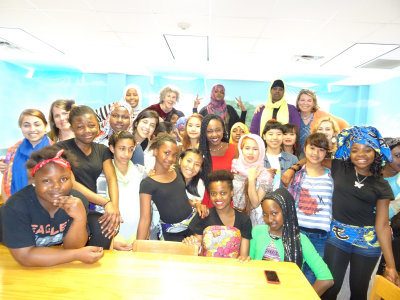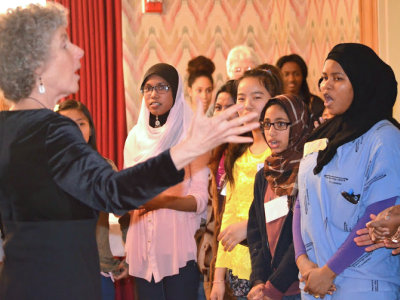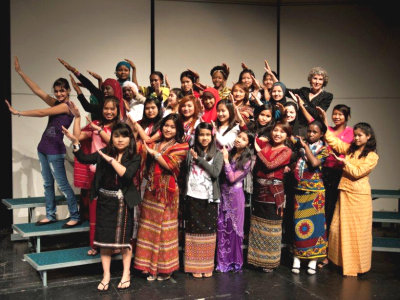 (photo by Pat Powers)
(photo by Pat Powers)
Good Vibrations
Elise Witt and the Global Village Project
by Leslie Zak
“Her performance is like a suitcase plastered with stickers from around the world…populated with interesting characters both heroic and comic.”
— The Raleigh Times
In music, a tuning fork is a classic vibratory instrument providing true pitch, used as a guide to all other tonal relationships. In life, it is Elise Witt.
Born in Switzerland to survivors of Nazi Germany, raised in North Carolina, Elise makes her home in Atlanta, Georgia. Speaking fluent Italian, French, German, Spanish, and English and singing in more than a dozen languages, Elise’s passion for music and language has carried her around the nation and across the seas. “My work and my life are all about sound,” says the multi-instrumentalist and longtime member of the Children’s Music Network.
Elise has long been aware that the first bone to develop in a baby transmits sound, and the last sense we lose is that of sound. “Sound is vibration,” she says. “It is literal waves in the air. We can physically feel them, and they have the power to move us. The incredible feeling I get from singing alone in a beautiful acoustic or immersed in the voices of singers around me is my greatest passion.
“When we hear the harmonies of a gospel choir or a mountain trio or a group of South African singers, we vibrate with the sound. We hear and feel the waves so close together they actually bump in the air. When we sing, the sound vibrates us to our core. It changes our molecules and the air around us. When we sing with others, we create an inexplicable but tangible, palpable connection.”
This passion has carved her career: sharing the power of singing with widely diverse groups, from schools to community choirs, from professional singers to those who, she says, “sadly believe they are ‘unmusical’ or ‘can’t carry a tune in a bucket.’”
Elise’s path has surely been paved by her ancestors from a broad-branched family tree, including composers Felix Mendelssohn and his sister, Fanny; Jewish philosopher Moses Mendelssohn; German Protestant cow farmers; Russian chemists; Polish intellectuals; French Bordeaux wine growers; a British painter; and a great-great-aunt from Cuba.
 (photo by Pat Powers)
(photo by Pat Powers)
Elise is the 2015 William L. Womack Creative Arts awardee, a recognition given to artists using their talents to build understanding between diverse communities. She has been a cultural ambassador to South Africa, Nicaragua, China, Italy, and Yugoslavia, and represented the State of Georgia at the Kennedy Center’s 25th Anniversary Celebration. She is at home on stages from Carnegie Hall, Lincoln Center, and the People’s Voice Café to the Martin Luther King Jr. Center for Non-Violent Social Change. Her festival work includes Clearwater’s Great Hudson River Revival; LEAF, the North Georgia Folk Festival; and the Marin County Fair in California. Currently, and whenever possible, she tours with the great singer-songwriters Becky Reardon and Terry Garthwaite, one of Elise’s longtime heroes.
Elise’s musical and pedagogical training is prolific and varied. She sang for twenty years with choral master Robert Shaw and has studied extensively with icons of improvisation Rhiannon and Bobby McFerrin, Pan-African vocal specialist Dr. Fred Onovwerosuoke, cellist David Darling, and Sweet Honey in the Rock’s Dr. Ysaye Barnwell, all of whose methods Elise incorporates into her own teaching.
The Georgia Council for the arts has named her a “state treasure.”
It’s an impressive, unique resume. Yet Elise feels that her current work with refugees is as important as anything she has done.
My Journey Yours
Since its inception in 2008, Elise has been the Director of the Music Program at the Global Village Project (GVP), a Georgia-accredited special-purpose middle school for refugee teenage girls from Afghanistan, Burma, Congo, Ethiopia, Eritrea, Iraq, Liberia, Nepal, Somalia, Sudan, and Central African Republic whose educations have been interrupted, their cultures uprooted—and for whom English is a second, third, fourth, or even fifth language.
Because music is located in every part of the human brain, Elise’s vocal program is an effective form of language and cultural immersion learning. Singing accelerates and deepens the learning of English, developing confidence and cooperation, while singing with their new American sisters opens communication in many important ways.
 (photo by Pat Powers)
(photo by Pat Powers)
With some twenty-plus languages spoken in GVP—most of the girls speak at least three—the program also feeds Elise’s own childhood dream of learning every language in the world.
“I know that all of my career has led me to this work,” says Elise.
Now in its seventh year, the GVP Music Program has expanded from an occasional all-school Circle Sing to providing music classes focusing on vocabulary building, pronunciation, ear training, writing skills, improvisation, and kinesthetic learning, and enhances classroom work by creating the opportunity for every student to participate in the Global Village Chorus.
One of Elise’s favorite activities with the girls is making a “Crankie” in the style of Bread and Puppet Theatre and “stuntologist” Sam Barlett. Using a long roll of butcher paper, song lyrics are written on the bottom. Students spend many quiet hours illustrating the words, then re-roll the paper. It then becomes a sing-along prompter when rolled through the Crankie box.
“Our first Crankie was ‘This Land Is Your Land,’ and it was fascinating to see their perceptions of those lyrics,” Elise observes. The girls’ favorite verses are the powerful last two, one describing long lines at the Relief Office, the other declaring that “nobody living can make me turn back” (from the freedom highway). She adds, “This last verse (from the American Civil Rights movement) we sing a cappella, slowly and quietly. Very quietly. There isn’t a dry eye in the house.”
Reaching open-heartedly into the refugee community, GVP created the Women’s Wisdom Project, a semester-long experience. Students in language arts classes learned how to conduct interviews, listen, and tell a story. They interviewed family members, discovering illuminating tales and histories about their own relatives they had never before heard.
Each class interviewed a female community leader. Mimi Vold, a Vietnamese refugee who now is a successful human resources director, shared her experiences with the GVP girls, something she had rarely done with other people. Students found that although their ethnicities, languages, and specific journeys were very different, the stories Ms. Mimi told often mirrored their own. The girls used her words verbatim to write their song, “I Believe We Have a Lot in Common.”
I Believe We Have a Lot in Common (Song for Ms. Mimi)
Elise notes, “The United States is changing rapidly with the arrival of refugees and immigrants from the many war-torn countries affected by our own policies.” The impact of this safe harbor made by music does not escape her. “Here, these young women can acclimate and explore their new environment, the world they will shape into their—and our—future. And I believe that music will be a vibrant part of their new world.”
Each year the students perform at Eve Ensler’s One Billion Rising, a global event to end violence against women and girls. Singing with vibrancy and purpose, they are led joyously by their music teacher, “Ms. Elise,” singing her song “Break the Silence.”
Break the Silence
Every successful teacher learns from students as much as teaching them, often in unexpected ways. Elise’s community connections and deepening relationships with their families—she lives within five blocks of most of her students—have informed her own work.
“After decades of traveling as a Teaching Artist-in-Residence, I was longing for a more in-depth continuous experience with a music team. The Global Village Project allows me to stay home and become even more deeply rooted in my community.” She muses, “It is almost a reversal of my former self, when I was helping Americans to appreciate world music and cultures. Now I’m getting new Americans to learn about their new country. It has made a difference in my own songwriting and recording.”
Salsa Garden
Elise’s songs could not be, and are not, only about sound and tone. Rhythm is also omnipresent, beginning and ending, as in life, with the heartbeat. Rhythm and Elise Witt—infectious, intricate, and unexpected—are inseparable. Embodying music as a physical activity, a kinetic experience, Elise, her students and her audiences are constantly moving to the beat, the “offbeat,” and the natural vibrations that make dancers of us all.
“Each language has its own rhythm and cadence. When we sing in foreign tongues, it changes us…the way we shape our mouths, use our face muscles, even our body language adapts.”
Inspired, she says, by CMN Magic Penny recipient Joanne Hammil and her song “Dreams of Harmony,” Elise’s recent recordings often layer the multiple rhythms of her students’ homelands, creating polyrhythmic sound collages.
I See You With My Heart
Earbone
Elise Witt: Artist, teacher, choral director, community and human rights activist. She shares her essence, rich with life’s constant humming vibrations—sound, movement, human connections—across a multilingual, multicultural, international soundscape. Her work is that of a true, honest, and honorable “People’s Artist.” There can be no greater accolade.